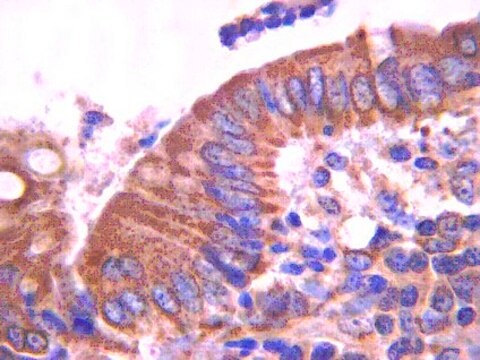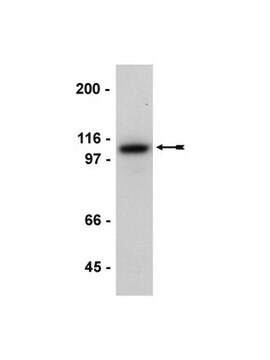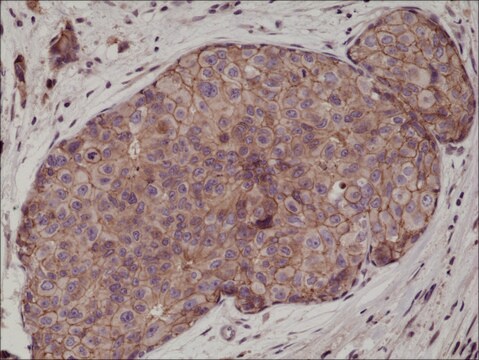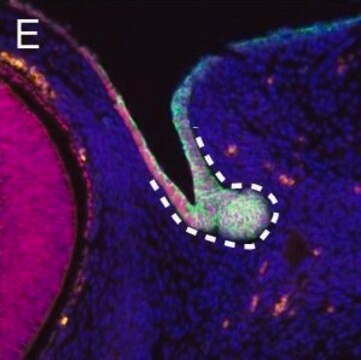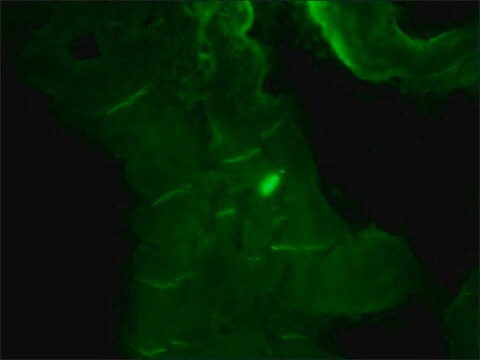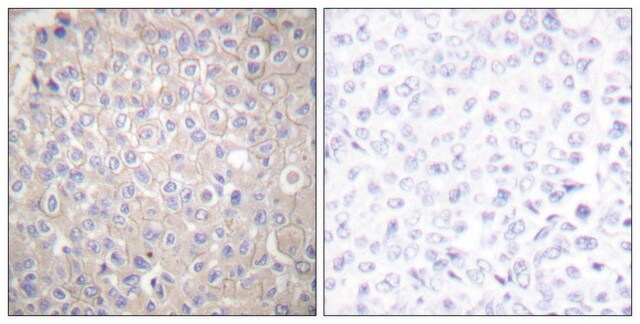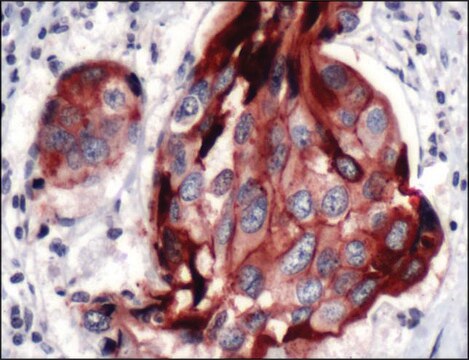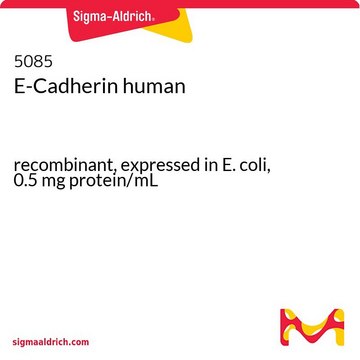推薦產品
生物源
mouse
品質等級
抗體表格
purified antibody
抗體產品種類
primary antibodies
無性繁殖
19A11, monoclonal
分子量
calculated mol wt 97 kDa
純化經由
using protein G
物種活性
human, canine
包裝
antibody small pack of 100
技術
ELISA: suitable
immunocytochemistry: suitable
inhibition assay: suitable
western blot: suitable
同型
IgG1κ
表位序列
N-terminal extracellular domain
Protein ID登錄號
UniProt登錄號
儲存溫度
-10 to -25°C
基因資訊
human ... CDH1(999)
特異性
Clone 19A11 is a mouse monoclonal antibody that detects E-Cadherin/CD324. It targets an epitope within the extracellular domain.
免疫原
Recombinant protein corresponding to the extracellular domain of human E-Cadherin.
應用
Quality Control Testing
Evaluated by Immunocytochemistry in MCF-7 cells.
Immunocytochemistry Analysis: A 1:1,000 dilution of this antibody detected E-Cadherin/CD324 in MCF-7 cells.
Tested Applications
Agonist Function:: A representative lot stimulated adhesion of cells to pure E-Cadherin substrate (Petrova, Y., et al. (2012). Mol Biol Cell.;23(11):2092-108).
Western Blotting Analysis: A representative lot detected E-Cadherin/CD324) in Western Blotting applications (Petrova, Y., et al. (2012). Mol Biol Cell. 23(11):2092-108; Xie, B., et al. (2022). Proc Natl Acad Sci USA. 119(32):e2204473119).
Immunocytochemistry Analysis: A representative lot detected E-Cadherin/CD324 in Immunocytochemistry applications (Petrova, Y., et al. (2012). Mol Biol Cell. 23(11):2092-108).
ELISA Analysis: A representative lot detected E-Cadherin/CD324 in ELISA applications (Petrova, Y., et al. (2012). Mol Biol Cell. 23(11):2092-108).
Note: Actual optimal working dilutions must be determined by end user as specimens, and experimental conditions may vary with the end user.
Evaluated by Immunocytochemistry in MCF-7 cells.
Immunocytochemistry Analysis: A 1:1,000 dilution of this antibody detected E-Cadherin/CD324 in MCF-7 cells.
Tested Applications
Agonist Function:: A representative lot stimulated adhesion of cells to pure E-Cadherin substrate (Petrova, Y., et al. (2012). Mol Biol Cell.;23(11):2092-108).
Western Blotting Analysis: A representative lot detected E-Cadherin/CD324) in Western Blotting applications (Petrova, Y., et al. (2012). Mol Biol Cell. 23(11):2092-108; Xie, B., et al. (2022). Proc Natl Acad Sci USA. 119(32):e2204473119).
Immunocytochemistry Analysis: A representative lot detected E-Cadherin/CD324 in Immunocytochemistry applications (Petrova, Y., et al. (2012). Mol Biol Cell. 23(11):2092-108).
ELISA Analysis: A representative lot detected E-Cadherin/CD324 in ELISA applications (Petrova, Y., et al. (2012). Mol Biol Cell. 23(11):2092-108).
Note: Actual optimal working dilutions must be determined by end user as specimens, and experimental conditions may vary with the end user.
標靶描述
Cadherin-1 (UniProt: P12830; also known as CAM 120/80, Epithelial cadherin, E-cadherin, Uvomorulin, CD324) is encoded by the CDH1 (also known as CDHE, UVO) gene (Gene ID: 999) in human. Cadherins are calcium-dependent cell adhesion molecules that participate in cell-cell adhesion during embryogenesis, development, organogenesis, and differentiation. E-cadherin is a single-pass type I membrane glycoprotein with tumor suppressive properties. It is synthesized with a signal peptide (aa 1-22) and a propeptide (aa 23-154) that are subsequently cleaved off to produce the mature form that contains an extracellular domain (aa 155-709), a transmembrane domain (aa 710-730), and a cytoplasmic domain (aa 731-882). N-glycosylation at Asn-637 is shown to be essential for its expression, folding, and trafficking. E-cadherin is known to contain five cadherin domains. Three calcium ions are usually bound at the interface of each cadherin domain and rigidify the connections, imparting a strong curvature to the full-length ectodomain. Post-translationally it can be cleaved into three chains: E-Cad/CTF1 (aa 701-882); E-Cad/CTF2 (aa 732-882); and E-Cad/CTF3 (aa 751-882). During apoptosis or with calcium influx, it is cleaved by a membrane-bound metalloproteinase (ADAM10; at residues 700-701), which causes disruption of cell-cell adhesion and the subsequent release of β-catenin into the cytoplasm. The residual membrane-tethered cleavage product is then rapidly degraded via an intracellular proteolytic pathway. It can also be cleaved by PS1/ -secretase (at residues 731-732) and this cleavage promotes disassembly of adherens junctions. Clone 19A11 is an activating monoclonal antibody that stimulates adhesion of cells to E-cadherin substrate. It modifies the adhesive properties of E-cadherin and prevent the metastatic invasion of mouse lung cancer cells expressing human E-cadherin. This clone is shown to bind to the extracellular domain of E-cadherin near its primary adhesive motif: the strand swap dimer interface, which strengthens adhesion by stabilizing strand-swap dimers. (Ref.: Xie, B., et al. (2022). Proc. Natl. Acad. Sci. USA. 119 (32); e2204473119; Petrova, YI., et al. (2012). Mol. Biol. Cell. 23(11); 2092-2108; Marambaud, M., et al. (2002). EMBO J. 21(8); 1948-1956; Steinhausen, U., et al. (2001). J. Biol. Chem. 276(7); 4972-4980).
外觀
Purified mouse monoclonal antibody IgG1 in PBS without preservatives.
重構
0.5 mg/mL. Please refer to guidance on suggested starting dilutions and/or titers per application and sample type.
儲存和穩定性
Store at -10°C to -25°C. Handling Recommendations: Upon receipt and prior to removing the cap, centrifuge the vial and gently mix the solution. Aliquot into microcentrifuge tubes and store at -20°C. Avoid repeated freeze/thaw cycles, which may damage IgG and affect product performance.
其他說明
Concentration: Please refer to the Certificate of Analysis for the lot-specific concentration.
免責聲明
Unless otherwise stated in our catalog or other company documentation accompanying the product(s), our products are intended for research use only and are not to be used for any other purpose, which includes but is not limited to, unauthorized commercial uses, in vitro diagnostic uses, ex vivo or in vivo therapeutic uses or any type of consumption or application to humans or animals.
未找到適合的產品?
試用我們的產品選擇工具.
儲存類別代碼
12 - Non Combustible Liquids
水污染物質分類(WGK)
WGK 2
閃點(°F)
Not applicable
閃點(°C)
Not applicable
分析證明 (COA)
輸入產品批次/批號來搜索 分析證明 (COA)。在產品’s標籤上找到批次和批號,寫有 ‘Lot’或‘Batch’.。
我們的科學家團隊在所有研究領域都有豐富的經驗,包括生命科學、材料科學、化學合成、色譜、分析等.
聯絡技術服務